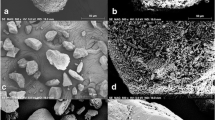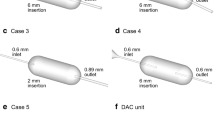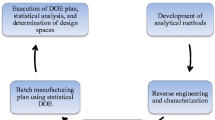Abstract
Pressurized metered dose inhalers (pMDIs) are frequently used for the treatment of asthma and chronic obstructive pulmonary disease. The aerodynamic particle size distribution (APSD) of the residual particles delivered from a pMDI plays a key role in determining the amount and region of drug deposition in the lung and thereby the efficacy of the inhaler. In this study, a simulation model that predicts the APSD of residual particles from suspension pMDIs was utilized to identify the primary determinants for APSD. These findings were then applied to better understand the effect of changing drug concentration and micronized drug size on experimentally observed APSDs determined through Andersen Cascade Impactor testing. The experimental formulations evaluated had micronized drug mass median aerodynamic diameters (MMAD) between 1.2 and 2.6 μm and drug concentrations ranging from 0.01 to 1% (w/w) with 8.5% (w/w) ethanol in 1,1,1,2-tetrafluoroethane (HFA-134a). It was determined that the drug concentration, micronized drug size, and initially atomized droplet distribution have a significant impact in modulating the proportion of atomized droplets that contain multiple suspended drug particles, which in turn increases the residual APSD. These factors were found to be predictive of the residual particle MMAD for experimental suspension HFA-134a formulations containing ethanol. The empirical algebraic model allows predicting the residual particle size for a variety of suspension formulations with an average error of 0.096 μm (standard deviation of 0.1 μm).









Similar content being viewed by others
REFERENCES
Heyder J, Gebhart J, Rudolf G, Schiller CF, Stahlhofen W. Deposition of particles in the human respiratory tract in the size range 0.005–15 μm. J Aerosol Sci. 1986;17(5):811–25.
Sheth P, Stein SW, Myrdal PB. The influence of initial atomized droplet size on residual particle size from pressurized metered dose inhalers. Int J Pharm. 2013;455:57–65.
Gonda I. Development of a systematic theory of suspension inhalation aerosols. I. A framework to study the effects of aggregation on the aerodynamic behaviour of drug particles. Int J Pharm. 1985;27:99–116.
Raabe OG. The dilution of monodispersed suspensions for aerosolization. Am Ind Hyg Assoc J. 1968;29:439–43.
Stein SW, Sheth P, Karayiannis C, Chiou H, Myrdal PB. Modeling MDI delivery: a priori predictions, empirical models and experiments. Resp Drug Deliv. 2010;1:353–64.
Stein SW, Sheth P, Myrdal PB. A model for predicting size distributions delivered from pMDIs with suspended drug. Int J Pharm. 2012;422(1):101–15.
Stein SW, Myrdal PB. A theoretical and experimental analysis of formulation and device parameters affecting solution MDI size distributions. J Pharm Sci. 2004;93(8):2158–75.
Stein SW. The influence of sample size on the accuracy of particle size distribution measurements. Resp Drug Deliv. 2008;333–336.
Jinks PA. Preparation and utility of sub-micron lactose, a novel excipient for HFA MDI suspension formulations. Proceedings of Drug Delivery to the Lungs, 14; 2003.
James J, Crean B, Davies M, Toon R, Jinks P, Roberts CJ. The surface characterisation and comparison of two potential sub-micron, sugar bulking excipients for use in low-dose, suspension formulations in metered dose inhalers. Int J Pharm. 2008;361(1):209–21.
Stein SW. Estimating the number of droplets and drug particles emitted from MDIs. AAPS PharmSciTech. 2008;9(1):112–5.
Acknowledgments
The authors would like to acknowledge the Pharmaceutical Research and Manufacturers of America (PhRMA) Foundation for a pharmaceutics predoctoral fellowship that supported this work.
Conflict of Interest
Stephen W. Stein is currently employed by 3M Drug Delivery Systems. Poonam Sheth and Paul B. Myrdal declared that no conflict of interest exists.
Author information
Authors and Affiliations
Corresponding author
Additional information
Guest Editors: Paul B. Myrdal and Steve W. Stein
Rights and permissions
About this article
Cite this article
Sheth, P., Stein, S.W. & Myrdal, P.B. Factors Influencing Aerodynamic Particle Size Distribution of Suspension Pressurized Metered Dose Inhalers. AAPS PharmSciTech 16, 192–201 (2015). https://doi.org/10.1208/s12249-014-0210-z
Received:
Accepted:
Published:
Issue Date:
DOI: https://doi.org/10.1208/s12249-014-0210-z




